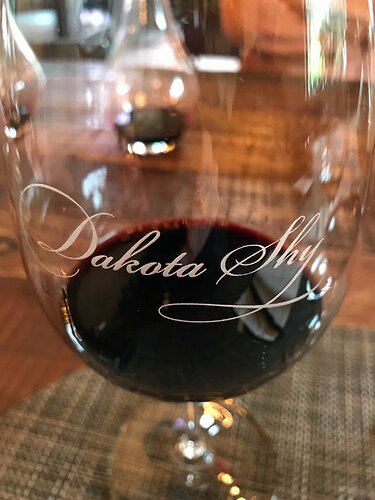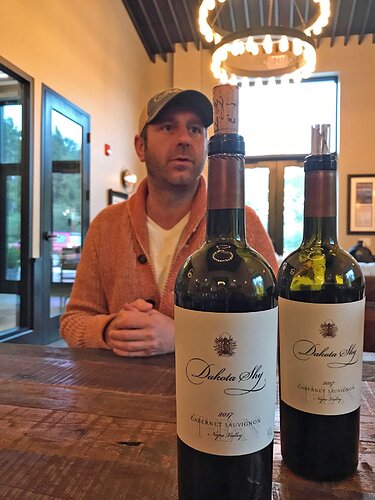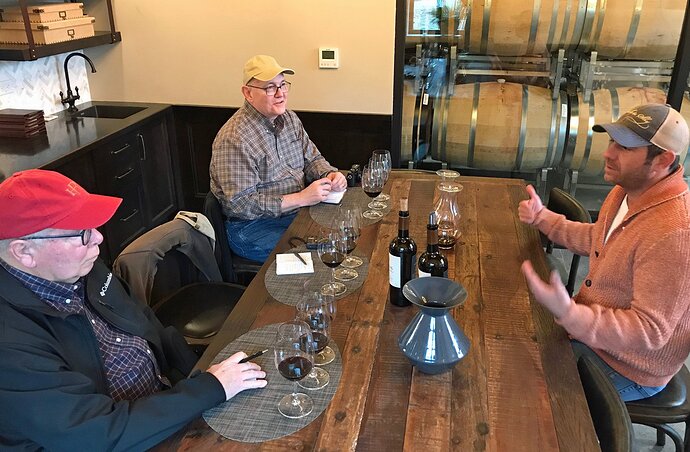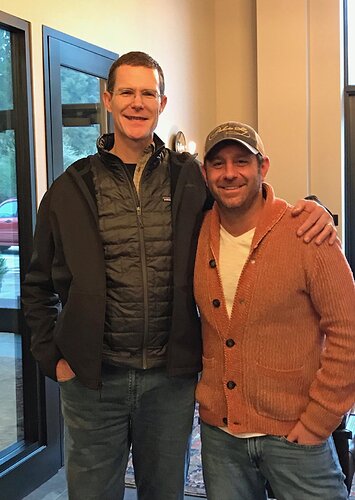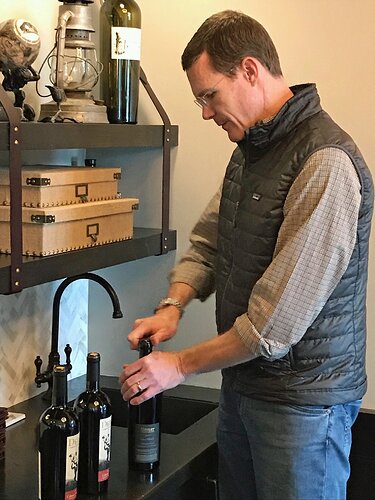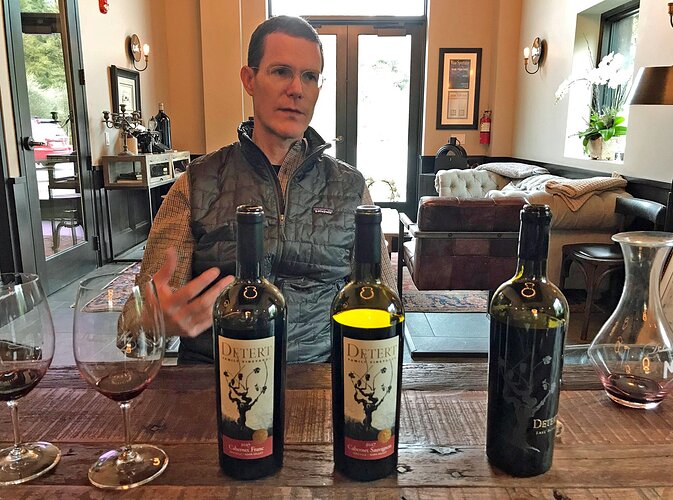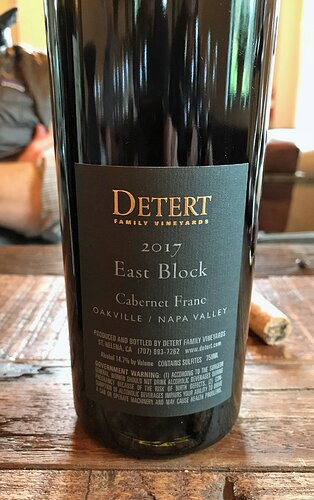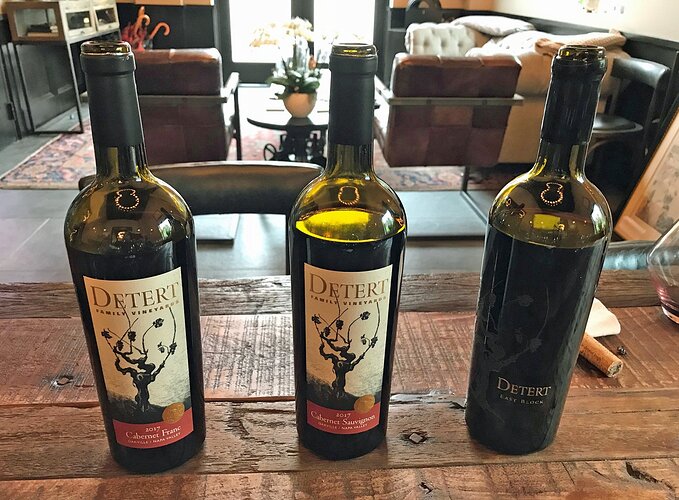Napa and Sonoma Wine Visits, January 2020 – Part 2a
I’ve posted a portion of Part 2 of a report on an early January three-day wine tour with friends Eric Anderson and Michael Poston to Napa and Sonoma wineries and tasting rooms. A second portion of Part 2 will be following soon, and Part 3 coming tomorrow. The full version of this report is on the Grape-Nutz.com website:
Napa and Sonoma Visits – January 2020 – Part 2
Dakota Shy Wine
Detert Family Vineyards
Dakota Shy Wine
The front gate was open when we arrived at Dakota Shy, just off of Silverado Trail, and we drove in and parked in front of the winery. We’d barely gotten out of the car when winery founder and partner Todd Newman came out from the tasting room to greet us. The winery is relatively new but has already made a splash. Eric had met Todd before and we were able to get an appointment to taste with him. Todd led us into the tasting room – modern yet with rustic touches that made it feel welcoming and unpretentious. Although Eric was already familiar with the winery, it was new to both Michael and me, and Todd talked with us about the background of both the winery and himself.
Todd is originally from North Dakota, and comes from a farming family. He told us that he’d thought about opening a high-end gastropub with a brewer friend in Minneapolis, but when the opportunity arose in 2003 for him to move to Napa Valley and work at a Michelin-starred restaurant – Martini House in St. Helena – he jumped at it. During his time there, Todd was able to make a lot of key contacts with well-known local vintners. One of those he met was Tom Garrett, a noted winemaker whose family has been farming their vineyard within the boundaries of the historic To-Kalon Vineyard since the 1950s. Tom hired Todd to work in the cellar at Revana Family Vineyard – Todd’s first winery experience – where he worked with Heidi Peterson Barrett among others. The long hours of learning to make wine served Todd well, but he found that interacting with customers as part of the business was a better fit for him, and he eventually became the director of Revana’s national sales program. In 2008, Todd partnered with Tom to launch the Dakota Shy label.
The focus of Dakota Shy from the start has been Cabernet Sauvignon, and their first release was from the 2012 vintage. Todd told us that he wanted to build the new Dakota Shy project from the ground up. He feels that the first ten years of the winery are laying their foundations, and they’re now getting ready for the next step. The property where the winery is located was purchased in 2013, and the winery was completed in 2017 – earlier vintages were made at Hourglass and Hunnicutt. As it turned out, the new facility was opened shortly before the devastating 2017 wine country fires, which came very close to the winery. The added construction expenses of installing a large water tank, fire sprinklers for the roof, and a generator paid off in helping to save the new building. What about the winery name? Todd said that friends used to call him “Dakota” and he said he was somewhat timid and unsure of himself early on – it also helps convey the idea of strength with humility.
Todd Newman
Nearly all of the Dakota Shy wines are sold direct to consumer, and with winery sales and marketing being a major role for Todd, it’s no surprise that he’s often on the road for sales trips, so we were fortunate in being able to catch up with him on this occasion. We were doubly fortunate to have Tom at the winery at the same time, as he and his winemaking staff were tasting 2019 wines in barrel the morning of our visit. Although he was busy with that while we talked and tasted with Todd, Tom was able to sit down with us afterwards and taste us on wines from his own Detert label. Dakota Shy is currently working with 16 vineyards throughout Napa Valley, and Todd said that they may look to buy a property to plant an estate vineyard. There are seven Cabernet-based bottlings, and total annual production is around 4,500 cases.
Todd had three wines for us to taste, beginning with the 2017 “TEN” Cabernet Sauvignon – “TEN” are Todd’s initials. This is 95% Cabernet Sauvignon and 5% Cabernet Franc, with fruit sourced from Rutherford, Calistoga, and Stags Leap District vineyards. The wine spent 18 months in barrel, with 70% new French oak – most of the Dakota Shy wines are aged in about 70-85% new oak, and they use a number of different coopers and toast levels in their barrel program. The “TEN” featured black cherry and currant aromas, with earth, spice, and dried herb notes plus well-integrated oak undertones, medium weight with a remarkably silky mouthfeel, and fine tannins on the finish. This wine is surprisingly approachable already, yet has good structure for aging. Todd told us that the “TEN” bottling is priced at less than $100 but is meant to compete with Napa Cabernets in the $150-175 price range – he noted that selling direct to consumer allows them to price wines for less than they would be able to if they had to go through distribution channels. He pointed out that the winery is not looking to do fancy packaging for their wines, in keeping with the “Dakota Shy” idea of humble strength.
Eric Anderson, Michael Poston, Todd Newman
Todd had two barrel samples for us to taste as well, beginning with 2018 Napa Valley Cabernet Sauvignon. This is sourced from hillside vineyards, and includes about 5% Petit Verdot. Very youthful, with lots of upfront black currant and darker berry fruit along with tobacco, earth, and mocha on the nose, a moderately rich yet still-lively texture, and a stony mineral note along with firm tannins on the finish. One more barrel sample was the 2018 Moulds Family Vineyard Cabernet Sauvignon, sourced from a site in the Oak Knoll District. This displayed a more plummy fruit profile plus an herbal character with hints of earth, smoke, spice, and pepper, a more structured mouthfeel and nicely-integrated tannins. The wine opened up with more air to reveal some intriguing minerally components. As we tasted, Todd spoke of some of the winery’s goals for their wines, for example creating wines that evoke emotions and wines with the textures of “liquid silk and ninja tannins.”
In addition to the wines we tasted with Todd, other Dakota Shy bottlings include several other Cabernet Sauvignon and Cabernet Franc bottlings, Rosé of Cabernet Sauvignon, and “McKenna’s” Sauvignon Blanc. Some of these are available only to wine club members. The Napa Valley Cabernet Sauvignon and the “TEN” are Dakota Shy’s two largest-production wines.
We enjoyed our visit with Todd quite a bit. It was easy to see that he’s well-suited to being the winery’s main connection with consumers, and we learned a lot from him in a short time. I’d never tasted the Dakota Shy wines before and was impressed. I thought all three that we tried showed great integration of oak, fine balance, and surprisingly tame tannins. Texturally they’re more subtle than many Napa Valley Cabs and I felt that this was a positive aspect of the wines – while I wouldn’t call them “old-school” Napa Cabs, they’re definitely not in the very ripe and bold style seen in recent years. The current 2017 “TEN” Cabernet Sauvignon was a particular favorite of the wines we tasted. I preferred the 2018 Napa Valley Cabernet Sauvignon of the two barrel samples, though both were obviously very young and will develop nicely for many years. I’d certainly recommend arranging a tasting at Dakota Shy if you’re visiting Napa Valley wineries.
Tom Garrett and Todd Newman
Detert Family Vineyards
After we finished up our visit and tasting with Todd Newman of Dakota Shy, winemaker Tom Garrett joined us in the tasting room. Eric had been able to get in contact with Tom, whom he’d met in the past, and fortunately Tom had some time to spend with us that morning and to taste us on his Detert Family Vineyards wines. Always good to get a “two-fer”!
Tom grew up in Santa Rosa, and his family has a long connection with Napa Valley. His great-grandfather and great-grandmother, Richard and Hedwig Detert, came to the US from Germany in the early 1900s and arrived in California in 1926 to manage various properties owned by Richard’s uncle William Detert. After Richard passed away in 1951, Hedwig sold their Guenoc Ranch property and purchased 50 acres of the famed To-Kalon Vineyard in the Oakville area in 1954 from the estate of previous owner Martin Stelling. Hedwig renamed this property the “Detert Vineyard,” and the family has farmed the vines there ever since. A large portion of their site had been planted with Cabernet Franc in 1949, the oldest planting of that variety in Napa Valley. Today, two branches of the Detert family share the vineyard – Tom’s part has mostly Cabernet Franc along with some Cabernet Sauvignon, while the part farmed by his cousins the MacDonald family is entirely Cabernet Sauvignon. Tom’s family farms about 18 acres of vines there, on gravelly alluvial soil at the base of the Mayacamas Mountains.
Tom Garrett
Early on, Robert Mondavi purchased the fruit when he was still at Charles Krug Winery, and Tom’s grandfather Gunther continued to sell fruit to Robert when he launched his own winery in 1966 – fruit from the Detert Vineyard has gone into Opus One bottlings as well. The family sold all of the Detert Vineyard fruit each year until 2000, when the first commercial vintage of Detert wine was produced, though about 60% of the Detert Vineyard fruit still goes to Robert Mondavi Winery. That 2000 vintage was from just one ton of Cabernet Franc, and the production of the Detert wines remains small, with a total of only about 700 cases made per year.
All fruit for the Detert wines comes from the estate vineyard, which is divided into three distinct blocks. Because of declining yields, the 1949 Cabernet Franc vines in the seven-acre East Block had to be replanted in 1979, but the budwood came from the original vines – this is now recognized at the Detert clone of Cabernet Franc. The ten-acre West Block has Cabernet Franc vines that were replanted in 2015, plus additional Cab Franc and Cabernet Sauvignon planted at that time. From 2000 to 2009, all of the Cab Franc from the East and West blocks was blended together, but beginning in 2009 a small amount of wine from East Block fruit has been bottled separately. The one-acre South Block is planted entirely to Cabernet Sauvignon – older vines there were replanted in 1997 with Clone 4 Cabernet. The first varietal Detert Cabernet Sauvignon bottling came in 2002.
Although Tom’s family was involved in growing winegrapes – and he’d helped his family make small lots of Cabernet Franc at home – he originally studied in college to become a doctor, then switched to English literature. But Tom eventually gravitated toward wine, and he became the tasting coordinator for Wine Spectator magazine in the 1990s. He left that position in 1999 to become a cellar hand at Turley Wine Cellars, where he worked with Ehren Jordan and Thomas Brown. Since then, he’s also worked at Joseph Phelps, Robert Mondavi, and at Revana Family Vineyards, where he worked with Heidi Peterson Barrett. Tom left his winemaking position at Revana in 2013 to focus full-time on Detert and on Dakota Shy, the only labels he currently makes wine for. Tom is one of three partners in Detert – he’s joined by his brother John and cousin Bill Cover. Mike Wolf is the vineyard manager and the estate vines are farmed using organic methods. Beginning in 2017, the Detert wines have been made at the new Dakota Shy winery, which Tom helped to design.
Tom Garrett
We tasted three pre-release wines with Tom – the first two will be released in March 2020, while the last one will be released in September. While the Detert wines are not always 100% varietal, Tom noted that the 2017 bottlings are. Tom started us out with the 2017 Cabernet Franc. This combined savory and herbal aromas with plum and currant fruit, plus notes of earth and spice with undertones of mocha, medium weight on the palate with a surprisingly silky texture and fine tannins. We followed the Cab Franc with the 2017 Cabernet Sauvignon – a bit darker fruit profile than the previous wine along with spice, dried herbs, a stony mineral note, and hints of vanilla/oak, with a bigger texture and grippier tannins on the finish.
As we tasted, Tom talked with us about his picking decisions for Cabernet Franc. His goal is bright, fresh, “snappy” fruit, and he’s looking for shifts in tannin and in acid/sugar balance as the fruit develops on the vines. He told us that he wants refinement and purity in the Detert wines, as well as freshness and energy. We asked him about differences in his winemaking between the Detert and Dakota Shy wines, and he told us that the winemaking style is very similar between the two, with a bit less new oak used in aging the Detert wines.
We finished our tasting with the 2017 “East Block” Cabernet Franc. This displayed more intense aromatics of black currant and darker fruit, along with earth, savory herbs, and a bit more spice than the previous two wines, with good structure and a lively mouthfeel, finishing with youthful tannins. Aside from a small amount of Cabernet Franc Rosé in some years, the three bottlings we tasted with Tom are the only ones that Detert produces.
It was a treat to be able to taste the three upcoming Detert wine releases with Tom. He was very low-key and relaxed in talking about his vineyard and wines, and Eric, Michael, and I really enjoyed all of the wines that Tom poured for us. In comparison with the Dakota Shy wines we’d tasted earlier that morning, I thought the Detert wines displayed somewhat more structure and texture, and though the tannins were a bit more obvious they were not at all aggressive – I’d describe the Detert wines as approachable yet very ageable. It was tough to pick a favorite among the three pre-release wines we tasted with Tom, but I’d have to say that the 2017 “East Block” Cabernet Franc was a particular standout, with the regular 2017 Cabernet Franc bottling close behind. These are all very distinctive wines, and I’d highly recommend arranging a visit to Detert next time you’re in Napa Valley.
